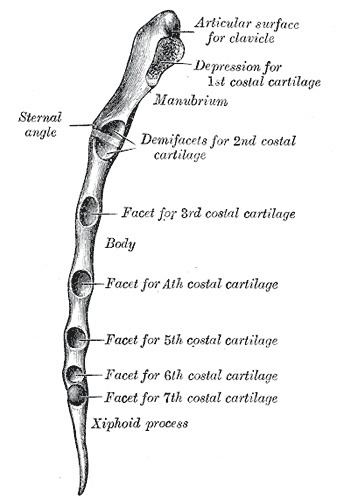Dorlands
/Elsevier a_42/12136357 FMA 7547 | TA A02.3.03.005 | |
 | ||
Latin angulus sterni, angulus sternalis | ||
The sternal angle (also known as the angle of Louis or manubriosternal junction) is the synarthrotic joint formed by the articulation of the manubrium and the body of the sternum.
Contents
The sternal angle is a palpable clinical landmark in surface anatomy.
Anatomy
The sternal angle, which varies around 162 degrees in males, marks the approximate level of the 2nd pair of costal cartilages, which attach to the second ribs, and the level of the intervertebral disc between T4 and T5. In clinical applications, the sternal angle can be palpated at the T4 vertebral level.
The sternal angle is used in the definition of the thoracic plane. This marks the level of a number of other anatomical structures:
compiled by
The angle also marks a number of other features:
The angle is in the form of a secondary cartilaginous joint (symphysis).
This is where the 2nd rib joins with the sternum. A clinically useful feature of the (manubriosternal) joint is that it can be palpated easily. This is because the manubrium normally angles posteriorly on the body of the sternum, forming a raised feature referred to as the sternal angle.
History
The sternal angle is also called the angle of Louis, but the reason for that name was lost. Once thought to be after Antoine Louis or Wilhelm Friedrich von Ludwig, it is now believed to be after Pierre Charles Alexandre Louis.
